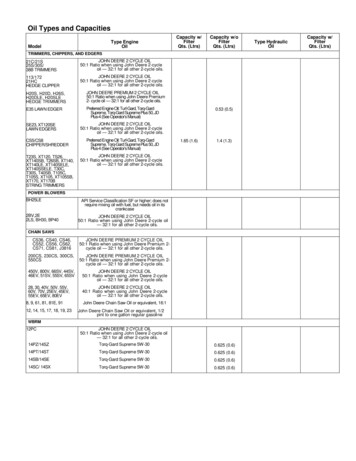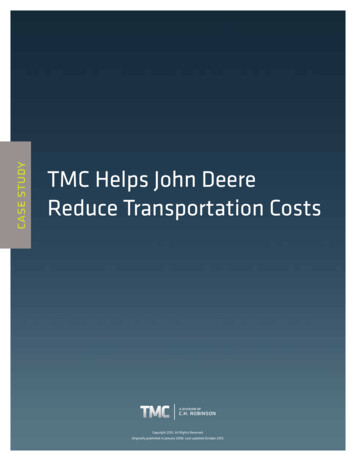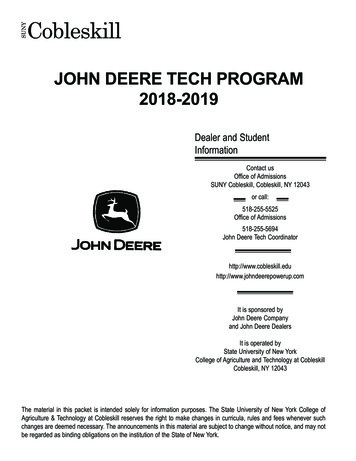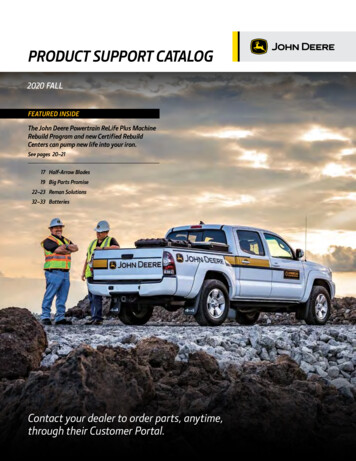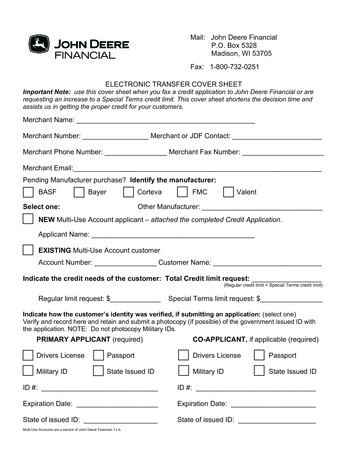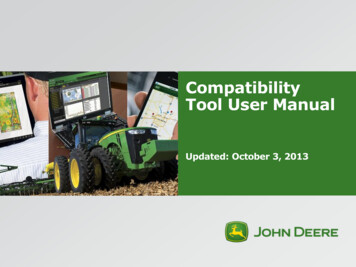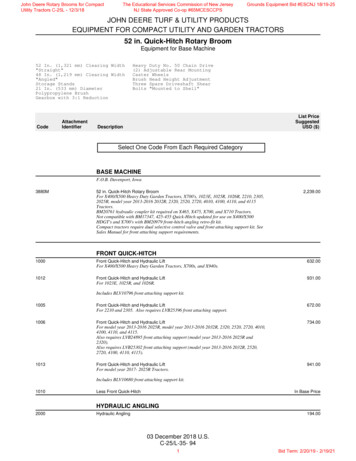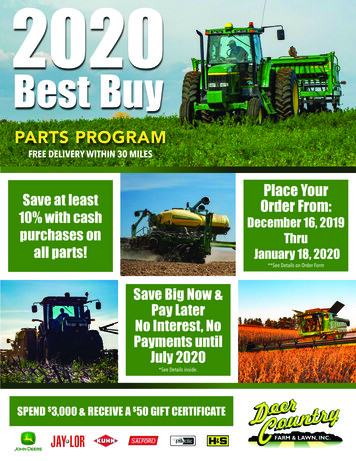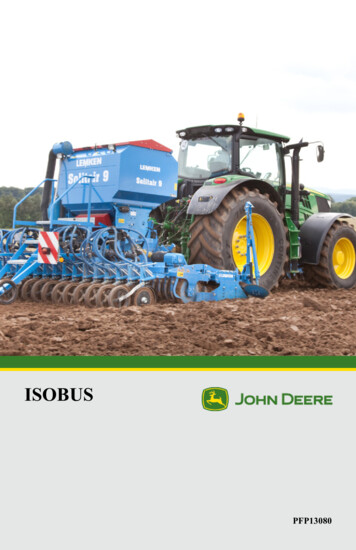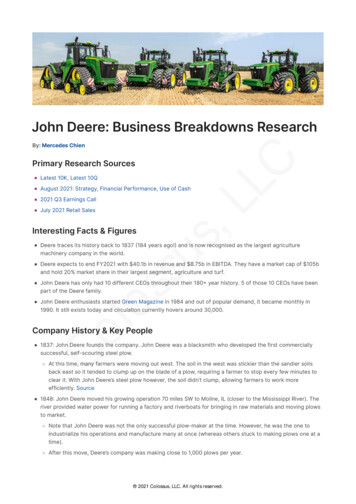
Transcription
John Deere: Business Breakdowns ResearchPrimary Research SourcesLatest 10K, Latest 10QAugust 2021: Strategy, Financial Performance, Use of Cash2021 Q3 Earnings CallJuly 2021 Retail Sales usInteresting Facts & Figures,L LCBy: Mercedes ChienDeere traces its history back to 1837 (184 years ago!) and is now recognised as the largest agriculturemachinery company in the world.Deere expects to end FY2021 with 40.1b in revenue and 8.75b in EBITDA. They have a market cap of 105band hold 20% market share in their largest segment, agriculture and turf. John Deere has only had 10 different CEOs throughout their 180 year history. 5 of those 10 CEOs have beenpart of the Deere family. John Deere enthusiasts started Green Magazine in 1984 and out of popular demand, it became monthly inloss 1990. It still exists today and circulation currently hovers around 30,000.CoCompany History & Key People 1837: John Deere founds the company. John Deere was a blacksmith who developed the first commerciallysuccessful, self-scouring steel plow. At this time, many farmers were moving out west. The soil in the west was stickier than the sandier soilsback east so it tended to clump up on the blade of a plow, requiring a farmer to stop every few minutes toclear it. With John Deere’s steel plow however, the soil didn’t clump, allowing farmers to work moreefficiently. Source 1848: John Deere moved his growing operation 70 miles SW to Moline, IL (closer to the Mississippi River). Theriver provided water power for running a factory and riverboats for bringing in raw materials and moving plowsto market. Note that John Deere was not the only successful plow-maker at the time. However, he was the one toindustrialize his operations and manufacture many at once (whereas others stuck to making plows one at atime). After this move, Deere’s company was making close to 1,000 plows per year. 2021 Colossus, LLC. All rights reserved.
1858: To prevent bankruptcy, John Deere reorganized the company and sold his interests to his son-in-law,Christopher Webber, and his son, Charles Deere. Charles took on most of his father’s managerial roles. 1868: Deere’s business reorganized again and became Deere & Co, as it is today.Early 1900s: Facing increased competition in the farming and agriculture manufacturing space (specificallyfrom International Harvester Company, now Navistar), Deere expanded its offerings to gasoline tractors—DailAll-Wheel Drive was its first model. 1918: Deere bought Waterloo Gasoline Engine Company (for 2.1m) which manufactured the Waterloo Boytractor in Iowa (many tractors are still manufactured in Waterloo, Iowa). Deere sold tractors under Waterlooname until 1923 when John Deere Model D was introduced. 1927-1929: Deere introduces first combine harvester (John Deere No. 2) followed by the smaller No.1. Duringthe Great Depression, the company never repossessed any equipment from American farmers. Source 1939-1945 (WWII): Charles Deere Wiman (John Deere’s great grandson) was president but accepted a LCcommission as colonel in the US Army. Deere Co manufactured military tractors and transmissions for the M3tank, in addition to farm machinery.Latter half of the 20th century marked a significant leap forward for Deere & Co and cemented their dominancein the industry. They launched a number of new products (select few listed below), each outdoing their lastmodel:,L 1960: Introduced “New Generation models 1010, 2010, 3010, 4010: 4 and 6-cylinder tractors These “10” series tractors propelled Deere from a 23% market share in 1959 to 34% in 1964. 1973: Introduced ‘Sound Idea’ tractors, models 4030, 4230, 4430, 4630. These features redesigned sheetusmetal and were available with an integrated operator’s cab that Deere called ‘Sound Gard body.’ These cabshad a roll-over protective structure and came with heat, AC, and speakers for an optional radio. 1989: Deere replaces the “New Generation” models of the 1960s 2017: Deere announced acquisision of Blue River Technology, a leader in applying ML to agriculture. Blue Riverlosshas designed and integrated computer vision and ML tech that will enable growers to reduce the use ofherbicides by spraying only where weeds are present 2019: Samuel R Allen announced he will step down as CEO and President of Deere Co. John May, President ofthe Worldwide Agriculture and Turf and Integrated Solutions division, will replace him. August 2021: Deere announces it will acquire Bear Flag Robotics, an agri tech co that enables a machine towork in a field autonomously. Source In latest Q3 Earnings Report, Deere will acquire Deere-Hitachi JV. Deere will enter long-term supplyCoagreement with Hitachi to source and manufacture the current products at existing locations. Source Other: John Deere currently consists of 6 brands: Source Deere & Co, Wirtgen (roadbuilding), Hagie (crop spraying solutions), PLA (grain elevators), Mazzotti(agricultural equipment), Monosem (vaccuum planters), A&I (wholesale distributor of aftermarketreplacement parts), Blue River (tech solutions), Harvest Profit (software for farmers to help track costs,profits, and inventory)Business Model & Secret SauceValue Proposition Deere traces its history back to 1837 (184 years ago!) and is now recognised as the largest agriculturemachinery company in the world. John Deere has approximately 69,600 employees with 27,500 in US/Canada. For over a century, Deere has been the pre-eminent manufacturer of critical agricultural equipment. Deere’sstrong brand has been built by its products which are known for being high-quality, durable, and efficient. Oneof the company’s stated aims is to reduce the total cost of ownership by making their machines: 2021 Colossus, LLC. All rights reserved.
More durable - can be used often and require replacing infrequently. Higher spec - can be used outside of daylight hours, for example. More efficient - use less fuel, chemicals, and labour (as well as increase yields). Deere is known as a technological leader in the industry, embedding intelligent systems within each product toincrease farmers’ efficiency. Over the past couple of decades, Deere has grown its capabilities to offer farmersguidance systems, connectivity, and automation of certain functions - like spacing and placing seeds in a feedto reduce wastage and increase yield. Deere is pursuing a strategy to increase autonomy in its products so farmers get more for less input. Thisdrive to full autonomy, backed by their strong brand, should increase switching costs if they can executewell.us,LLC Here is an overview of their technological leadership and push to autonomy: lossSourceThe company’s strategy focuses on delivering a comprehensive solution for farmers. Their products targetCoeach phase of the farming process, including preparation, planting/seeding, applying chemicals, andharvesting:SourceProducts: 2021 Colossus, LLC. All rights reserved.
Their operations are organised into three principle business segments:,LSourceLC Agriculture and Turf: Construction and Forestry: manufactures and distributes a range of machines and service parts used inconstruction, earthmoving, material handling and timber harvesting — including backhoe loaders, fourwheel-drive loaders and excavators.us Financial Services: finances sales and leases by John Deere dealers of new and used agriculture and turfequipment and construction and forestry equipment, and provides wholesale financing to dealers of theJohn Deere-branded equipment.Distribution:loss John Deere’s products and services are marketed primarily through a network of independent retaildealerships and major retail outlets, which deal directly with the Company’s own in-house sales teams.Often, these are ongoing relationships with multi-year sales agreements. The breadth of Deere’s dealer network is unmatched, with over 1900 locations in North America and approx.3700 globally (with significant presence on every continent). It is difficult to compete with this scope, particularly as dealers offer farmers convenient access to afterComarket parts and services. Deere provides ongoing support services to customers, in the form of financing solutions,maintenance and protection plans, servicing and parts, and safety and training assistance. They also sell a selection of products to customers on a self-service basis through their online store. Their major market is the US. Based on 2020 Revenue, geographical split is as follows: US: 53% Canada: 7% Western Europe: 15% Central Europe/CIS: 6% Latin America: 9% Asia, Africa, AUS, NZ, Middle East: 10% Geographic goals are to increase market share specifically in India and Brazil.Economics 2021 Colossus, LLC. All rights reserved.
Revenue: Worldwide net sales net income: 2020: 35.5 bn 2.8 bn 2019: 39.3 bn 3.3 bn Agriculture and turf is the company’s most important business line. Net sales split as follows for eachbusiness segment, with associated operating margins:Agriculture and Turf:LCConstruction and Forestry:us,LFinancial Services:Source Sales by product line:loss Large Agri: 32% Small Agri: 23% Construction: 10% Financial Products: 10% Roadbuilding: 8% Turf:7% Compact Construction: 4% Forestry: 3% Other: 3%Costs: Unsurprisingly, manufacturing agricultural machines is capital intensive. Deere’s cost of sales hovers around75%. In FY’20, they spent 4.6% of revenue on R&D, 9.8% on SG&A, and 3.5% on interest expenses. Margin Expansion, Cash Flow, Debt serviceCo FY21: Analysts expect gross margins to reach 30%, EBITDA margin to reach 21%, and Net Income marginto reach 14.8% FY20 saw actuals of 24% gross margin and net income margin of 8%. FCF FY20 was 6.6b and analysts expect that to decrease to 5.1b in FY21. Deere’s debt to ebitda ratio was 7.2x (on the higher end). Analysts expect that to decrease to 4.07x in 2021.Competitive Advantage Brand. Deere has one of the world’s most valuable brands. They deliver world class products and value-addedservices through their global dealer network. This brand loyalty gives them pricing power and raises the barrierto compete for other brands. Deere leads market share in agricultural equipment at close to 20%. Source With the growth of both the traditional agriculture market (valued in the trillions) and the smartagriculture market (use of tech and IoT to make farmer more productive and efficient - global market 2021 Colossus, LLC. All rights reserved.
valued at 13b in 2020 and expected to grow at a CAGR of 10.1% until 2026), Deere has a solid footholdin the industry to grow with it. Market data, Market data Relationships with third party dealerships and retailers across the globe that will be hard to replicate by newentrants. Data and speed to market. Deere has employed the use of machine learning algorithms to forecast demand fortheir seasonal business and help farmers increase yields. The more data it has to use, the more effective andaccurate the results are, the more useful it can be to their customers - farmers. They have over a century ofdata from operations to use. Their extensive manufacturing capabilities around the globe help them manage and maintain demand andsupply from different retailersCompetitive PositionLCIndustry (they have a number of competitors in each vertical they operate in): Competition: the main criteria to differentiate in this industry are product performance, innovation andquality, distribution, customer service and price. In North America and many other parts of the world, John Deere’s brand recognition is a competitive Deere faces competition in each vertical.,Lfactor. Agriculture and turf segment: AGCO Corporation, CLAAS KGaA mbH, CNH Industrial N.V., Kubota TractorCorporation, Mahindra, and The Toro Company and regional and local competitors.As technology becomes increasingly important to enable productivity in agriculture, the industry isattracting non-traditional competitors including more technology-focused companies and start-upventures. The agricultural equipment industry continues to undergo significant changes and isus becoming even more competitive through the emergence and expanding global capability of manycompetitors, particularly in high potential markets such as Brazil and India where Deere seeks tolossincrease market share. The segment’s turf equipment is sold primarily in North American and WesternEuropean markets. Construction and forestry segment include Caterpillar Inc., CNH Industrial N.V., Doosan Infracore Co.,Ltd. and its subsidiary Doosan Bobcat Inc., Fayat Group, Komatsu Ltd., Kubota Tractor Corporation,Ponsse Plc, SANY Group Co., Ltd., Terex, Tigercat Industries Inc., Volvo Construction Equipment (part ofVolvo Group AB) and XCMG.Co There are extremely high barriers to entry in this industry. It’s capital intensive and is dominated by legacyplayers. Additionally, Deere has manufacturing plants all over the globe, a capital intensive endeavor for anystartup or upcoming competitor. Position within industry: Brand: Deere’s brand is its best competitive advantage. Deep entrenched network of suppliers and distributors: John Deere uses a variety of agreements withsuppliers intended to drive innovation, ensure availability and delivery of industry-leading quality rawmaterials and components, manage costs on a globally competitive basis, protect John Deere’s intellectualproperty, and minimize other supply-related risks. IP: Deere’s vast IP (patent, manufacturing, designs) also contribute to its strong moat John Deere owns a significant number of patents, trade secrets, licenses, and trademarks related toJohn Deere products and services, and expects the number to grow as John Deere continues to pursuetechnological innovations. John Deere’s policy is to further its competitive position by filing patent applications in the U.S. andinternationally to protect technology and improvements considered important to the business.Risks 2021 Colossus, LLC. All rights reserved.
There are a number of risks to Deere (execution risk and not innovating quickly enough, government risk,macroeconomic risk). Below are a select few: Deere operates in a cyclical industry. Demand for its products (agriculture and construction) changes in linewith macroeconomic conditions. Sales of agricultural equipment are affected by total farm cash receipts, which reflect levels of farmcommodity prices, acreage planted, crop yields and government policies, including global trade policies andthe amount and timing of government payments. Sales are also influenced by general economic conditions, farm land prices, farmers’ debt levels and accessto financing, interest and exchange rates, agricultural trends, including the production of and demand forrenewable fuels, labor availability and costs, energy costs, tax policies and other input costs associatedwith farming. The prevailing levels of residential, commercial and public construction, investment in infrastructure, andthe condition of the forestry products industry influence retail sales of John Deere construction,earthmoving, roadbuilding, material handling, and forestry equipment. General economic conditions, the LClevel of interest rates, the availability of credit and certain commodity prices, such as oil and gas and thoseapplicable to pulp, paper and saw logs also influence salesDeere is also subject to emissions regulation, which has become more of a focus in recent years. The European Union’s Stage V Regulation, parts of which became effective in 2019 and 2020, applies to,Lnon-road diesel engines across various power categories for machines used in construction, agriculture,materials handling, industrial use and generator applications. Governmental agencies throughout the worldare enacting similar laws to reduce off-road engine emissions, including India’s Bharat Stage IV Regulationthat will become effective in 2021.Deere has achieved and plans to continue to achieve compliance with these regulations throughus significant investments in the development of new engine technologies and after-treatment systems.Compliance with emissions regulations has added and will continue to add to the cost of JohnDeere’s products.loss Governments are also implementing laws regulating products across their life cycle, including raw materialsourcing and the storage, distribution, sale, use, and disposal of products at their end-of-life. These lawsand regulations include green chemistry, right-to-know, restriction of hazardous substances, and producttake-back laws.Useful ResourcesTypeCoTitleWhat You Will LearnURLJohn Deere 2020 AnnualReport Highlights and AnalysisArticleA 2020 Financial Overview and an analyst’sestimates on what John Deere needs to do inthe future to continue winning this ohndeere-2020-annual-reporthighlightsFarm to Data Table: JohnDeere and Data in PrecisionAgricultureArticleThe exact technology benefits and challengesof precision agriculture sionagriculture/The role tractor maker JohnDeere has to play in the futureof farmingArticleAn overview on the future of John Deerefarming and R&D deerefuture-farming/On Life and Land by JohnDeerePodcastA series on farmer’s stories on agriculture,farming, and -andland/id1439108033Agriculture TechnologyPodcast: Ep. 144 John DeereModel Year '22 Sprayer UpdatePodcastAn update from a farmer on John Deere’s latestmodels. The broader series goes deep onprecision agriculture ts/agriculture-technologypodcast-ep.-144-john- 2021 Colossus, LLC. All rights reserved.
Colossus,LLCdeere-model-year-'22sprayer-update 2021 Colossus, LLC. All rights reserved.
John Deere has only had 10 different CEOs t hroughout t heir 180 year histor y. 5 of t hose 10 CEOs have been par t of t he Deere family. John Deere ent husiasts star ted in 1984 and out of popular demand, it became mont hly in 1990. It still exists today and circulation current ly hovers around 30,000. Green Magazine Company Histor y .
